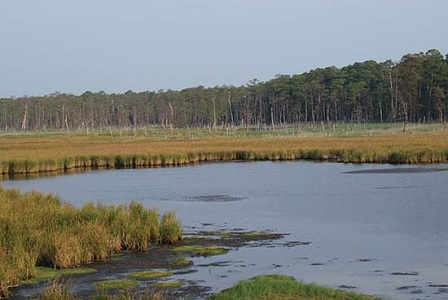
Courtesy of Blackwater National Wildlife Refuge via Wikimedia Commons
Situated between the Chesapeake Bay and the Atlantic Ocean, Maryland’s Eastern Shore features a rich landscape containing a patchwork of woodlands, streams, swamps, agricultural fields, and open water. Somewhat isolated from the rest of the state, the region’s interface of flat terrain and crisscrossing waterways has influenced the development of distinctive economic practices and cultural traditions among its residents. To match its visual resplendence, the Eastern Shore houses a wealth of history. Particularly significant is the region’s Dorchester County area, the birthplace of the famous abolitionist and civil rights advocate, Harriet Tubman.
Today considered a national hero, Tubman is best known for her role in assisting approximately 70 enslaved African Americans escape to freedom as a leading “conductor” of the Underground Railroad – a resistance movement based on self-liberation and flight. The Harriet Tubman Underground Railroad National Historical Park (HATU) memorializes this legacy not through physical structures, but by instead through the landscape in Tubman’s native Dorchester County, Maryland which has been preserved by private and public stewards.
Born Araminta Ross to enslaved parents in 1822, the future humanitarian grew up living in slavery on a plantation in the Dorchester County area. At the age of 13, young “Minty” suffered a severe injury from a blow to the head with a two-pound weight, following her refusal to assist an overseer in the restraint of a runaway slave. The physical repercussions of this injury affected Tubman for the rest of her life. While still a slave, Araminta adopted the name “Harriet” at the time of her marriage to John Tubman, a free black man, around the year 1844. Tubman and her husband continued to live and work in Dorchester County for several years until her escape from slavery in 1849, at the age of 27. Ultimately settling in Auburn, New York, Tubman returned to the Dorchester area a total of 13 times over the following decade to guide her family members and dozens of other fugitive slaves north to freedom.
Throughout the Civil War, Tubman contributed to the Union cause in a multitude of roles, serving at various times as a cook, nurse, scout, and even spy. She helped plan and lead the Combahee River raid in South Carolina that helped free over 700 enslaved men, women, and children. After the war’s end, Harriet focused her efforts on the women’s rights movement, working alongside such prominent activists as Susan B. Anthony and Lucretia Mott to promote women’s suffrage. In the later years of her life, Tubman continued to care for African Americans in need through the establishment of the Harriet Tubman Home for the Aged in 1908. Five years later, she died of pneumonia on March 10, 1913.
Although she lived out her final decades in New York, the dense marshes and green woodlands of Maryland’s Eastern Shore are where Harriet Tubman first grew spiritually and physically strong. The area’s vibrant scenery offers a compelling backdrop evoking the narrative of Tubman’s early life, escape from enslavement, and experience as conductor for the Underground Railroad. Spending her formative years working in the fields, woodlands, and waterways of Dorchester County, Tubman acquired the survival skills necessary for her success guiding freedom-seekers northwards and, later, as a Union scout and spy.
Within the bounds of HATU lie two other significant Underground Railroad sites. Located near the area’s western edge, Stewart’s Canal – built by enslaved labor as a trade route in the 1830s – opened up some of Dorchester’s more remote territory to the Chesapeake Bay, helping the enslaved population connect with the northern route to freedom. Near the canal is the home site of Jacob Jackson, a free black man who assisted Tubman in her efforts to guide runaway slaves northward. Jackson aided Tubman in communicating secretly with her family that she would return to Dorchester and guide her three enslaved brothers to freedom.
HATU offers visitors a unique experience in which they must rely on the terrain – rather than physical structures – to relay the narrative of Harriet Tubman’s life in Dorchester and envision the experiences of those who escaped slavery on the Underground Railroad. With a landscape relatively unchanged since Tubman’s time, visitors to HATU are invited to explore the site’s natural features and experience the interface of fields, marshlands, and waterways in much the same way as Harriet Tubman.
The National Park Service (NPS) administers HATU and works in partnership with the US Fish and Wildlife Service, which manages the Blackwater National Wildlife Refuge, and the State of Maryland, which owns and co-manages the Harriet Tubman Underground Railroad Visitor Center, to commemorate and interpret Tubman’s story.
Last updated: February 28, 2018
